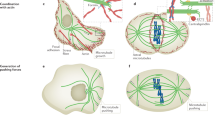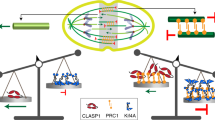Abstract
The guanosine tri-phosphatase Ran stimulates assembly of microtubule spindles. However, it is not known what aspects of the microtubule cytoskeleton are subject to regulation by Ran in mitosis. Here we show that Ran–GTP stimulates microtubule assembly by increasing the rescue frequency of microtubules three- to eightfold. In addition to changing microtubule dynamics, Ran–GTP also alters the balance of motor activities, partly as a result of an increase in the amount of motile Eg5, a plus-end-directed microtubule motor that is essential for spindle formation. Thus, Ran regulates multiple processes that are involved in spindle assembly.
This is a preview of subscription content, access via your institution
Access options
Subscribe to this journal
Receive 12 print issues and online access
$209.00 per year
only $17.42 per issue
Buy this article
- Purchase on Springer Link
- Instant access to full article PDF
Prices may be subject to local taxes which are calculated during checkout






Similar content being viewed by others
References
Waters, J. C. & Salmon, E. Pathways of spindle assembly. Curr. Opin. Cell Biol. 9, 37–43 (1997).
Heald, R. & Walczak, C. E. Microtubule-based motor function in mitosis. Curr. Opin. Struc. Biol. 9, 268–274 (1999).
Desai, A. & Mitchison, T. J. Microtubule polymerization dynamics. Annu. Rev. Cell Dev. Biol. 13, 83–117 (1998).
Cassimeris, L. Accessory protein regulation of microtubule dynamics throughout the cell cycle . Curr. Opin. Cell Biol. 11, 134– 141 (1999).
Belmont, L. D., Hyman, A. A., Sawin, K. E. & Mitchison, T. J. Real-time visualization of cell cycle-dependent changes in microtubule dynamics in cytoplasmic extracts. Cell 62, 579– 589 (1990).
Verde, F., Dogterom, M., Stelzer, E., Karsenti, E. & Leibler, S. Control of microtubule dynamics and length by cyclin A- and cyclin B-dependent kinases in Xenopus egg extracts. J. Cell Biol. 118, 1097– 108 (1992).
Gliksman, N. R., Parsons, S. F. & Salmon, E. D. Okadaic acid induces interphase to mitotic like microtubule dynamic instability by inactivating rescue. J. Cell Biol. 119, 1271–1276 (1992).
Zhai, Y., Kronebusch, P. J., Simon, P. M. & Borisy, G. G. Microtubule dynamics at the G2/M transition: abrupt breakdown of cytoplasmic microtubules at nuclear envelope breakdown and implications for spindle morphogenesis . J. Cell Biol. 135, 201– 214 (1996).
Tournebize, R., Heald, R. & Hyman, A. Role of chromosomes in assembly of meiotic and mitotic spindles. Prog. Cell Cycle Res. 3, 271– 84 (1997).
Holy, T. E. & Liebler, S. Dynamic instability of microtubules as an efficient way to search in space. Proc. Natl Acad. Sci. USA 91, 5682–5685 ( 1994).
Andersen, S. S. L. Balanced regulation of microtubule dynamics during the cell cycle: a contemporary view. Bioessays 21, 53– 60 (1999).
Karsenti, E., Newport, J., Hubble, R. & Kirschner, M. W. Interconversion of metaphase and interphase microtubule arrays as studied by the injection of centrosomes and nuclei in eggs. J. Cell Biol. 98 , 1730–1745 (1984).
Heald, R. et al. Self-organization of microtubules into bipolar spindles around artificial chromosomes in Xenopus egg extracts. Nature 382, 420–5 (1996).
Zhang, D. & Nicklas, R. Chromosomes initiate spindle assembly upon experimental dissolution of the nuclear envelope in grasshopper spermatocytes . J. Cell Biol. 131, 1125– 31 (1995).
Zhang, D. & Nicklas, R. The impact of chromosomes and centrosomes on spindle assembly as observed in living cells. J Cell Biol 129, 1287–300 (1995).
Dogterom, M., Felix, M., Guet, C. & Leibler, S. Influence of M-phase chromatin on the anisotropy of microtubule asters. J. Cell Biol. 133, 125–40 ( 1996).
Hoyt, M. A. & Giese, J. R. Genetic analysis of mitotic spindles . Annu. Rev. Genet. 30, 7– 33 (1996).
Vale, R. D. & Milligan, R. A. The way things move: looking under the hood of molecular motors. Science 288, 88–95 (2000).
Mountain, V., Simerly, C., Howard, L., Schatten, G. & Compton, D. A. The kinesin-related protein, HSET, opposes the activity of Eg5 and cross-links microtubules in the mammalian mitotic spindle. J. Cell Biol. 147, 351–365 (1999).
Sharp, D. J. et al. Functional coordination of three mitotic motors in Drosophila embryos. Mol. Biol. Cell 11, 241– 253 (2000).
Walczak, C. E., Vernos, I., Mitchison, T. J., Karsenti, E. & Heald, R. A model for the proposed roles of different microtubule-based motor proteins in establishing spindle bi-polarity . Curr. Biol. 8, 903–913 (1998).
Kalab, P., Pu, R. T. & Dasso, M. C. The ran GTPase regulates mitotic spindle assembly. Curr. Biol. 9, 481–484 ( 1999).
Wilde, A. & Zheng, Y. Stimulation of microtubule aster and spindle assembly by the small GTPase Ran. Science 284 , 1359–1362 (1999).
Ohba, T., Nakamura, M., Nishitani, H. & Nishimoto, T. Self-organization of microtubule asters induced in Xenopus egg extracts by GTP-bound Ran. Science 284, 1356– 1358 (1999).
Carazo-Salas, R. E. et al. Generation of GTP-bound Ran by RCC1 is required for chromatin-induced mitotic spindle formation. Nature 400, 178 –181 (1999).
Zhang, C., Hughes, M. & Clarke, P. R. Ran–GTP stabilises microtubule asters and inhibits nuclear assembly in Xenopus egg extracts. J. Cell Sci. 112, 2453–2461 (1999).
Sawin, K. E., LeGuellec, K., Philippe, M. & Mitchison, T. J. Mitotic spindle organization by a plus-end directed microtubule motor. Nature 359, 540–543 ( 1992).
Blangy, A. et al. Phosphorylation of p34 cdc2 regulates spindle association of human Eg5, a kinesin-related motor essential for bi-polar spindle formation in vivo. Cell 83, 1159– 1169 (1995).
Meyer, T. U. et al. Small molecule inhibitor of mitotic spindle polarity identified in a phenotype-based screen. Science 286, 971–974 (1999).
Walczak, C. E., Verma, S. & Mitchison, T. J. XCTK2: a kinesin-related protein that promotes mitotic spindle assembly in Xenopus laevis egg extracts. J. Cell Biol. 136, 859–870 ( 1997).
Heald, R., Tournebize, R., Habermann, A., Karsenti, E. & Hyman, A. Spindle assembly in Xenopus egg extracts: respective roles of centrosomes and microtubule self-organization . J. Cell Biol. 138, 615– 28 (1997).
Sawin, K. E. & Mitchison, T. J. Mutations in the kinesin-like protein Eg5 disrupting localization to the mitotic spindle. Proc. Natl Acad. Sci. USA 92, 4289–4293 (1995).
Theurkauf, W. & Hawley, R. Meiotic spindle assembly in Drosophila females: behavior of nonexchange chromosomes and the effects of mutations in the nod kinesin-like protein. J. Cell Biol. 116, 1167–80 (1992).
Mitchison, T. J. & Kirschner, M. W. Isolation of mammalian centrosomes. Methods Enzymol. 134, 261–268 (1986).
Murray, A. W. Cell cycle extracts. Methods Cell Biol. 36, 581–605 (1991).
Tournebize, R. et al. Distinct roles of PP1 and PP2A-like phosphatases in control of microtubule dynamics during mitosis. EMBO. J 16, 5537–5549 (1997).
Fanara, P., Oback, B., Ashman, K., Podtelejnikov, P. & Brandt, R. Identification of MINUS, a small polypeptide that functions as a microtubule nucleation suppressor. EMBO J. 18, 565–577 (1999).
Hyman, A. A. Preparation of marked microtubules for the assay of the polarity of microtubule based motors by fluorescence. J. Cell Sci. (Suppl.) 14, 125–127 (1991).
Carazo-Salas, R. E., Gruss, O. J., Mattaj, I. W. & Karsenti, E. Ran–GTP coordinates regulation of microtubule nucleation and dynamics during mitotic-spindle assembly. Nature Cell Biol. 3, 228–234 (2001).
Acknowledgements
We thank T. Kapoor and T. Mitchison (Harvard Medical School) for Monastrol, O. Martin for purifying Ran and for critical reading of the manuscript, L. Cassimeris (Lehigh Univ.) for advice on analysing microtubule dynamics, E. Salmon (Univ. North Carolina) for advice on image analysis, A. Khodjakov (Wadsworth Center) for PKG cells used for centrosome isolation, and R. Gunawardane for comments on the manuscript. This work was supported by a postdoctoral fellowship from the American Cancer Society (to C.W.), NIH grants (to Y.Z. and C.E.W.), and a Pew Scholar's award (to Y.Z.).
Author information
Authors and Affiliations
Corresponding author
Rights and permissions
About this article
Cite this article
Wilde, A., Lizarraga, S., Zhang, L. et al. Ran stimulates spindle assembly by altering microtubule dynamics and the balance of motor activities. Nat Cell Biol 3, 221–227 (2001). https://doi.org/10.1038/35060000
Received:
Revised:
Accepted:
Published:
Issue Date:
DOI: https://doi.org/10.1038/35060000
This article is cited by
-
The effects of glipizide on DNA damage and nuclear transport in differentiated 3T3-L1 adipocytes
Molecular Biology Reports (2022)
-
Spatiotemporal control of spindle disassembly in fission yeast
Cellular and Molecular Life Sciences (2019)
-
Mitotic spindle assembly in animal cells: a fine balancing act
Nature Reviews Molecular Cell Biology (2017)
-
Influence of white spot syndrome virus infection on hepatopancreas gene expression of ‘Huanghai No. 2’ shrimp (Fenneropenaeus chinensis)
Journal of Ocean University of China (2017)
-
Connecting the microtubule attachment status of each kinetochore to cell cycle arrest through the spindle assembly checkpoint
Chromosoma (2015)



